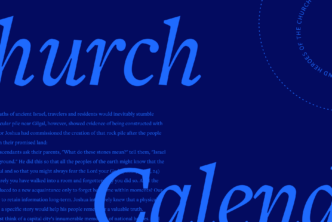What is heresy? While this term is often casually thrown around in the many wars of words on social media, it does have a historic technical usage in the context of Christian theology. Simply put, we can define heresy as the deliberate affirmation of a belief that subverts a central doctrine of the faith.
This introduction to heresy will first unpack this definition in a bit more detail before considering what the Bible says about heresy. Then we will examine some of the most important heresies that arose in the first centuries after Christ and consider the legacy of heresy for Christians today.
Table of contents
Characteristics of heresy
Heresy can only be understood relative to its opposite, orthodoxy. From the Greek word meaning “right belief,” orthodoxy refers to those doctrines that, in the words of the fifth-century monk St. Vincent of Lérins, have been believed “everywhere, always, and by all.” In other words, when a belief has found wide geographic acceptance over many centuries by Christians of all stripes, we can be assured that it is a central doctrine of the faith. Such a core set of beliefs was first expressed in the “rule of faith” (regula fidei) of the early church and then crystallized in the creeds, such as the Apostles’ and Nicene Creeds.1
Thus, by extension, heresy can best be understood as affirmation of a belief that ultimately undermines one of these core tenets of orthodoxy. A disagreement over a secondary or tertiary issue, one which by definition is not central to Christian orthodoxy per the aforementioned Vincentian canon, cannot therefore be a matter of heresy.
It is, moreover, important to recognize that heresy is an intentional, deliberate deviation from orthodoxy. Ignorance of core doctrine, while certainly problematic in its own right, is not ultimately the same kind of error as heresy. In other words, while heresy is a sin, honest confusion or ignorance is not. It is also not the same as unbelief, for heresy is better understood as false belief rather than the absence of belief altogether.
Heresy, then, has been traditionally understood—and punished—as a sin of particular gravity. The early church often deposed, exiled, and anathematized heretical clerics. Convinced of their heresy, the medieval church executed leading Reformers such as the Oxford Martyrs. Not even the Reformation-era Protestants let heresy go unpunished. Calvin’s Geneva sentenced the heretic Michael Servetus to be burned at the stake, and many Anabaptists were drowned in what was termed their “third baptism.” Following the European Wars of Religion, however, temporal punishment for heresy effectively ceased in the Christian West.
Heresy in the Bible
The Greek hairesis is used in the New Testament both in a neutral sense to speak of a “school,” “sect,” or “party” (e.g., Acts 5:17; 15:5; 24:5; 26:5) as well as in the negative sense of a “faction” or “division” (e.g., 1 Cor 11:18–19; Gal 5:20; 2 Pet 2:1)—a sect or party that is known for its bitter, divisive character. The one instance of the Greek word hairesis that most clearly anticipates the more technical notions of “heresy” as a belief that threatens fundamental doctrines of the faith is found in 2 Peter 2:1.
But false prophets also arose among the people, just as there will be false teachers among you, who will secretly bring in destructive heresies, even denying the Master who bought them, bringing upon themselves swift destruction. (2 Pet 2:1 ESV)

Run a Bible Word Study in Logos on the Greek word hairesis.
By the early second century, the word hairesis (and its Latin form, haeresis) had taken upon the more technical notion of “heresy” that we think of today.2
While the technical use of the word “heresy” may not be common in the New Testament, the concept of false and destructive teaching is a frequent concern for many New Testament writers. Paul, for example, frequently warns against such false teachers (e.g., 1 Tim 1:3–6) and criticizes false teaching (1 Cor 15:12–58). In response, Paul exhorts Christians to “guard the good deposit entrusted to you” (2 Tim 1:14) and expel the false teachers among them (Titus 3:10). Biblical scholars debate the extent to which various proto-heresies are being targeted in the New Testament writings. Still, it is clear that, at minimum, serious doctrinal divisions threatened to obscure the core message of the gospel even from the dawn of Christianity.
9 heresies in early Christianity
No understanding of Christian theology is complete without a firm grasp of the central heresies combated by the early church. The struggle against heresy had lasting significance for the Christian faith, insofar as false teachings provoked the early church to more carefully define and defend its beliefs and practices. The need to combat heresy contributed to the writing of creeds, the formalization of the biblical canon, and the increased emphasis on the episcopacy and apostolic succession as means of safeguarding orthodoxy.3
The following heresies, presented in something of a chronological order from earliest to latest, are some of the most important for the formation of Christian doctrine in the early Church (AD 100–500):
1. Ebionism
This heresy refers to early views of Jesus that identified him merely as a human prophet, inspired by the Holy Spirit but not divine. The Ebionites were almost certainly Jewish Christians committed to understanding Jesus through traditional Jewish paradigms. According to Irenaeus, they used only the Gospel of Matthew, rejecting the Pauline writings as incompatible with their view of Christ.
2. Docetism
Docetism was the belief that Jesus only appeared to have a human body (so named after the Greek dokeō, “to appear”). This view appears to be the focus of the Johannine epistles’ warning about false teachers (1 John 4:1–3); it was a major influence on Gnostic Christology. The letters of Ignatius of Antioch show particular concern to refute Docetism.
3. Gnosticism
Gnosticism refers to the beliefs of a broad range of disparate ancient Hellenistic groups that were concerned to distinguish between a lesser creator god and the one true God. Heavily influenced by Platonism, Gnostics were generally characterized by a negative attitude toward the material world and its ignorant creator (the Demiurge). Salvation comes through acquiring secret spiritual knowledge that allows believers freedom from the physical world. The discovery of the Nag Hammadi Library in 1945 greatly increased our understanding of the Gnostics by giving us access to their own writings.
4. Marcionism
Named after its founder Marcion of Sinope, this heresy is perhaps best known for its rejection of the Old Testament. In this system, Yahweh of the Old Testament is an ignorant and evil deity; Jesus, on the other hand, came to reveal the true God. Marcion is often credited with creating the first Christian canon of Scripture. Marcion’s Bible was limited to a highly censored version of the Gospel of Luke and some of the Pauline epistles.
5. Modalism
Sometimes called modalistic monarchianism, Sabellianism, or patripassianism, this heresy held that the Father, the Son, and the Holy Spirit are merely different modes or aspects of the one divine person, much like one man can be a father, a son, and a husband. Such beliefs were rejected by writers such as Tertullian, whose treatise against the modalist Praxeas set out the case for both unity and distinction within the Godhead. Such responses to modalism were thus essential for establishing the orthodox view of the Trinity.
6. Montanism
More precisely termed the New Prophecy, this heresy arose in Phrygia in the middle of the second century. Montanus and his followers combined a charismatic belief in the continuation of authoritative prophecy with a rigorous asceticism and apocalyptic expectations. The movement’s rural origins, disregard for church hierarchy, and claims to fresh divine revelation earned its condemnation. Montanism nevertheless left a mark on the later writings of Tertullian and on some of the martyr literature from the second century.
7. Arianism
This heresy refers to the Christological positions following from the views of the presbyter Arius of Alexandria. Trying to reconcile the worship in Christ with monotheism, Arius suggested that “there was [a time] when he [the Son] was not.” In other words, the Son was the firstborn and greatest of all creation, made before the heavens and the earth. Nevertheless, in this view he was still, ultimately, a creature, and therefore not fully divine. Arianism was condemned at the Council of Nicaea (325), and after the resurgence of such views in the mid-fourth century (commonly called Neo-Arianism), re-condemned at the Council of Constantinople (381).
8. Pneumatomachianism
This mouthful refers to the denial of the full divinity of the Holy Spirit among those who otherwise confessed the deity of the Son. The apparent basis for their objection to the Spirit’s divinity was their belief that this view lacked explicit biblical support. Their views were countered by Basil of Caesarea, among others, with Pneumatomachianism condemned at the Council of Constantinople (381), which affirmed the distinct divine personhood of the Holy Spirit.
9. Pelagianism
This heresy is named after the British monk Pelagius, though scholars debate precisely what views Pelagius himself held. Pelagianism refers to the belief that human beings are completely free, such that it is possible of one’s own free will to not sin. Human nature has not been corrupted by what Augustine of Hippo would develop as the notion of original sin. For Augustine, original sin seriously corrupts or distorts human free will such that we need God’s grace. Pelagianism was condemned at several councils, including the Council of Ephesus (431).
The Bauer Thesis
It is worth noting that many scholars today take a more skeptical view of the categories “orthodoxy” and “heresy.” That is to say, they reject the narrative in which an early, pristine orthodoxy was threatened by a series of movements that deliberately aimed to undermine this orthodoxy. For these scholars, “orthodoxy” is only the label the winning party gave to itself. This position was originally staked out by the famous German scholar Walter Bauer, and the Bauer Thesis continues to find traction among those committed to postmodern presuppositions about the relative nature of truth. Heresy, from this perspective, is simply the name given to the doctrinal views that lost.4
Scholars who follow Bauer are likely correct that the reality of doctrinal development in early Christianity was a lot messier than it is portrayed in the writings of the early church fathers. Heresies indeed often arose within the churches as attempts not to destroy the church but rather to safeguard it. Likewise, scholars have demonstrated that the fathers often grouped together under a single label several views that in reality were considerably more diverse than their writings would suggest.
These valid critiques do not, however, undermine the reality of an original, authoritative apostolic proclamation. The essential truths of the gospel, summarized in the church’s “rule of faith,” established the central tenets of the Christian religion. On this apostolic basis, orthodoxy would continue to develop and be refined.
Heresy today
One of the chief reasons for learning about these heresies is that many of them persist, albeit in subtle ways. After all, no one today advertises themselves as an Arian or a Montanist or some other brand of clearly labeled heretic. And yet many key aspects of these ancient heresies endure in the popular Christian imagination. For example, contemporary calls to “unhitch” the Old Testament from the Christian faith are simply updated forms of Marcionism. Groups such as the Jehovah’s Witnesses that deny the distinct divine personhood of the Holy Spirit are merely recapitulating the errors of the Pneumatomachians.
Such errors can even creep into the mindsets of many otherwise orthodox Christians. For example, the well-meaning analogy of the Trinity as water, which can exist as liquid, ice, and vapor, is in fact a description of modalism. Likewise, songs that suggest that this present world “shall soon dissolve like snow,” could be construed as advancing a form of Gnosticism against the orthodox emphasis on the resurrection of the body in the restored creation.
Digging deeper into heresy
As always, the best place to learn more about orthodoxy and heresy is to return to the original sources. For example, reading both the Nag Hammadi corpus and Irenaeus’s Against Heresies will provide an excellent introduction to Gnosticism and some of the other early heresies. Athanasius’s On the Incarnation provides a masterful refutation of Arian ideas. Augustine’s anti-Pelagian writings are still engaging reads centuries later.
For those looking for a more curated collection of primary sources with some introductory commentary, the volumes on the Trinitarian and Christological controversies in the Sources of Early Christian Thoughts series are excellent resources.5
Related articles
- The Nicene Creed: A Very Brief Introduction
- To Creed or Not to Creed: Why You Need Creeds in the Christian Life
Unity without Compromise: Councils & Creeds for Today’s Ecumenical Dialogue - Navigating Pneumatology: How to Study the Holy Spirit
More resources about the development of Christian doctrine
How the Spirit Became God: The Mosaic of Early Christian Pneumatology
Regular price: $17.99
The Story of Creeds and Confessions: Tracing the Development of the Christian Faith
Regular price: $34.99
- On this topic, see further Frances Young, The Making of the Creeds (London: SCM, 1991).
- See e.g., Ignatius, Eph. 6.2; Justin, Dial. 51.2. For additional references and a further account of the history of this term, see TDNT 1.180–184, s.v. hairesis. See also Alister McGrath, Heresy: A History of Defending the Truth (New York: HarperOne, 2009), 37–39.
- This way of thinking about heresy and its effects was impressed upon me by Justo L. González, The Story of Christianity (New York: HarperOne, 2010), 1.75–81.
- For further description of the Bauer thesis and the scholarly landscape, see McGrath, Heresy, 1–13, 64–80.
- See William G. Rusch, ed., The Trinitarian Controversy (Philadelphia: Fortress, 1980); Richard A. Norris, ed., The Christological Controversy (Philadelphia: Fortress, 1980). Other good resources for introducing this period and its theological debates are John Behr, The Way to Nicaea (Crestwood, NY: St Vladimir’s Seminary Press, 2001); John Anthony McGuckin, The Westminster Handbook of Patristic Theology (Louisville, KY: WJKP, 2004).









